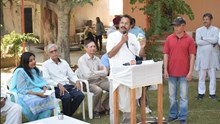
Union Minister of Ports, Shipping and Waterways, Sarbananda Sonowal, chaired a meeting to review the progress of the National Maritime Heritage Complex (NMHC) project in Lothal, Gandhinagar, Gujarat.
During the meeting, a memorandum of understanding (MoU) was signed with the Ministry of Defence, specifically the Indian Navy and Coast Guard, to collaborate on the development of a Naval gallery within the NMHC complex. This gallery, titled "The Journey of Indian Navy & Coast Guard," aims to showcase the historical journey of these maritime forces.
Sarbananda Sonowal expressed his appreciation for the efforts in developing the NMHC complex under the leadership of Prime Minister Narendra Modi. He emphasized that the project, which is part of the Sagarmala Programme, aims to highlight India's rich maritime heritage and will become the world's largest maritime museum complex.
The Minister also mentioned that the NMHC will serve as a center for learning and understanding India's maritime history. It is being designed to be easily accessible and comprehensible to the general public. Sonowal extended his gratitude to the Government of Gujarat for its continuous support in the development of the project.
The Chief Minister of Gujarat expressed his satisfaction with the progress made on the project and assured full cooperation from the state government in fulfilling the assigned responsibilities. Dr. Mansukh Mandaviya praised the efforts of the Gujarat state government and urged all stakeholders to coordinate further to ensure the project is completed within the specified timelines.
The Gujarat government has allocated 375 acres of land for the NMHC project, as well as an additional 25 acres for staff quarters. The development of a four-lane road from the State Highway to the NMHC project site is underway. Narmada water supply over a distance of 25 km has already been completed, along with the laying of transmission lines and the establishment of a 66 kV GIS substation. The Gujarat government has contributed Rs. 150 crore towards the development of basic internal infrastructure.
The NMHC, under the Sagarmala Programme, is being developed on approximately 400 acres of land with an estimated cost of Rs. 4500 crore. The project is planned to be funded by public and private institutions, as well as through corporate social responsibility (CSR). Major ports in India have contributed Rs. 209 crore towards the project.
Shripad Naik, Minister of State for Ports, Shipping and Waterways, highlighted that the NMHC is envisioned as a world-class international tourist destination, the first of its kind in India. It will comprise a maritime museum, a lighthouse museum, maritime theme parks, and amusement parks, among other attractions. The objective is to present India's maritime heritage from ancient to modern times through an edutainment approach.
Shantanu Thakur, Minister of State for Ports, Shipping and Waterways, emphasized that the NMHC will advance India's position globally and educate individuals about the rich heritage of the maritime sector. He stated that the project aligns with the goals of Amritkal and MIV 2030.
The construction of a 1.58 km four-lane road from Saragwada village to the project site is near completion. A 25 km water supply line and a water tank with a capacity of 10 lakh liters have been completed. Phase 1A of the project has progressed by more than 30%. Tenders for the first five galleries, including the naval gallery and Lothal town, have been floated. The procurement of special pink stones from Jodhpur for the NMHC facade works is underway. Collaborations with various state departments and institutes for the inclusion of artifacts in the museums have been established.
The Ministry of Ports, Shipping and Waterways has identified 74 projects worth Rs. 57,000 crore under the Sagarmala program in Gujarat. Out of these, 15 projects worth Rs. 9,000 crore have been completed, 33 projects worth over Rs. 25,000 crore are under implementation, and 26 projects worth Rs. 22,700 crore are under development. These projects are being jointly implemented by central line ministries, major ports, state maritime boards, and other state agencies.
















